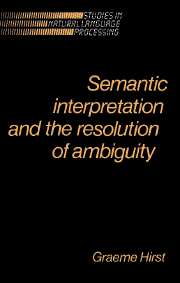Summary
This book is based on my doctoral dissertation at Brown University, submitted in December 1983. I have revised it extensively; in particular, I have kept the literature reviews up to date, and tried to take account of related work on the same topic that has been published since the original dissertation.
The work herein is interdisciplinary, and is perhaps best described as being in cognitive science. It takes in artificial intelligence, computational linguistics, and psycholinguistics, and I believe that it will be of interest to researchers in all three areas. Accordingly, I have tried to make it comprehensible to all by not assuming too much knowledge on the reader's part about any field. The incorporation of complete introductory courses was, however, impractical, and the reader may wish to occasionally consult introductory texts outside his or her main research area.
Organization of the book
Chapter 1 is an introductory chapter that sets out the topic of the work and the general approach. The problems of semantic interpretation, lexical disambiguation, and structural disambiguation are explained. For readers who haven't come across them before, there are also brief overviews of frame systems and case theories of language; people who already know it all can skip this. I then describe the research, and in particular the Frail frame language and the Paragram parser, that was the starting point for the present work.
Chapters 2 and 3 form Part I, on semantic interpretation. Chapter 2 is a detailed examination of past research on the topic, and discusses properties desirable in a semantic interpreter.
- Type
- Chapter
- Information
- Semantic Interpretation and the Resolution of Ambiguity , pp. xi - xivPublisher: Cambridge University PressPrint publication year: 1987

